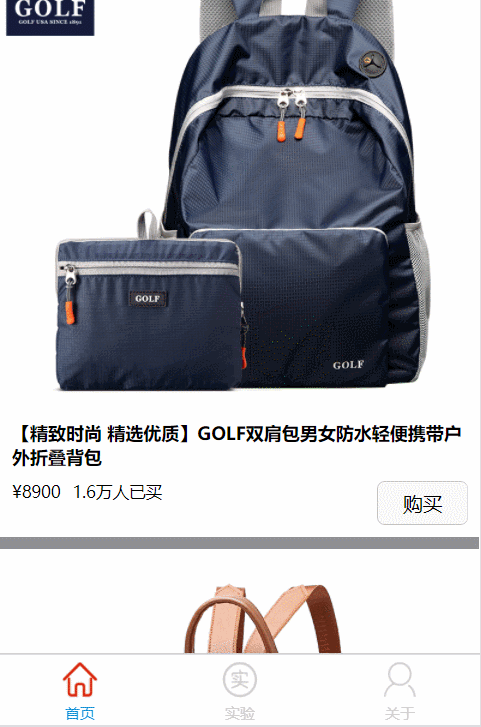效果:

1.Fly官网地址:https://wendux.github.io/dist/#/doc/flyio/readme
2.项目文件:
2.1 网络请求的request.js
//目前没有针对uni的Fly版本,使用wx版本没有问题,引入Fly
import Fly from 'flyio/dist/npm/wx'
//创建Fly实例
const request = new Fly()
//将箭头函数实例赋值给errorPrompt
//箭头函数相当于
//function (err) {
// uni.showToast({
// title: err.message || 'fetch data error.',
// icon: 'none'
// })
//}
const errorPrompt = (err) => {
uni.showToast({
title: err.message || 'fetch data error.',
icon: 'none'
})
}
//添加Fly的请求拦截器,可以通过它在请求之前做一些预处理
//请求拦截器中的request对象结构如下:
//{
// baseURL, //请求的基地址
// body, //请求的参数
// headers, //自定义的请求头
// method, // 请求方法
// timeout, //本次请求的超时时间
// url, // 本次请求的地址
// withCredentials //跨域请求是否发送第三方cookie
//}
request.interceptors.request.use((request) => {
uni.showLoading({
title: '加载中'
});
return request
})
//添加响应拦截器,响应拦截器会在then/catch处理之前执行
//promise 承诺,承诺需要完成的两件事,指定承诺需要完成的事,设置承诺是否实现的标准
//resolve和reject是判断承诺是否实现的两个函数
//如果请求成功,且response.data调用里有数据,说明承诺已经实现了,调用resolve方法
//如果进入了处理错误的方法,说明请求被拒绝了,调用reject方法
//响应拦截器中的response对象结构如下
//{
// data, //服务器返回的数据
// engine, //请求使用的http engine(见下面文档),浏览器中为本次请求的XMLHttpRequest对象
// headers, //响应头信息
// request //本次响应对应的请求信息
//}
request.interceptors.response.use((response, promise) => {
uni.hideLoading();
return promise.resolve(response.data)
}, (err, promise) => {
//错误走到这里,隐藏加载中,toast错误信息,处理错误
uni.hideLoading();
errorPrompt(err)
return promise.reject(err)
})
//export用于对外输出本模块(一个文件可以理解为一个模块)变量的接口,其他JS文件就可以通过import命令加载这个模块(文件)
export default request
2.2处理网路请求的store.js
//引入request.js文件
import request from 'common/request'
//const定义的变量不可以修改,而且必须初始化。
//async,异步方法用来处理请求网络数据,因为请求网络数据可能耗时,如果同步,则会影响体验和性能
const getProducts = async function (page=1) {
//let是块级作用域,函数内部使用let定义后,对函数外部无影响。
//var定义的变量可以修改,如果不初始化会输出undefined,不会报错,且变量的作用域是全局的
let url = `https://api.beidian.com/mroute.html?method=beidian.h5.shop.product.list&page=${page}&shop_id=682731`;
console.log(url);
//使用await是执行顺序控制,每执行一个await,程序都会暂停等待await返回值,然后进行下一步
//只能在async方法里,使用await
//调用Fly实例的get方法,发起网络请求
const data = await request.get(url);
if (data.has_more) {
return data.shop_products;
} else {
return false;
}
}
const search = async function(keywords, page=1) {
keywords = encodeURI(keywords);
let url =
`https://api.beidian.com/mroute.html?method=beidian.search.item.list&keyword=${keywords}&sort=hot&page_size=20&page=${page}`;
console.log(url);
const data = await request.get(url);
if (data.has_more) {
return data.items;
} else {
console.log("没有数据了!")
return false;
}
}
//每个模块内部,module变量代表当前模块,这个变量是一个对象,它的exports属性(module.exports={})是对外的接口。加载某个模块,其实是加载该模块的module.exports属性。
//exports var exports = module.exports; exports是引用 module.exports的值,而模块导出的时候,真正导出的执行是module.exports,而不是exports
module.exports= {
getProducts,
search,
}
2.3视图页面index.vue
<template>
//flex:1 让所有弹性盒模型对象的子元素都有相同的长度,且忽略它们内部的内容:
<view style="flex-direction: column; flex: 1;">
<block v-for="(item,index) in productList" :key="index">
<view class="">
<view style="flex-direction: column; flex: 1;">
<view style="height: 750upx;">
<image :src="item.img" mode="" style="width: 100%; height: 100%;"></image>
</view>
<view style="padding-top: 30upx; padding-left: 20upx; padding-right: 20upx; font-size: 30upx; font-weight: bold;">
{{item.title}}</view>
<view style="padding: 20upx;">
<view>
<view>
¥{{item.price}}
</view>
<view style="padding-left: 20upx;">
{{item.seller_count}}
</view>
</view>
<view class="" style="flex: 1; justify-content: flex-end;">
<view>
<button type="danger" size="mini">购买</button>
</view>
</view>
</view>
</view>
</view>
<view class="" style="background-color: #8F8F94; height: 20upx;"></view>
</block>
</view>
</template>
<script>
import service from 'service/store.js';
export default {
data: {
productList:[
]
},
async onLoad() {
const productList = await service.getProducts(1);
this.productList=productList;
console.log(JSON.stringify(productList));
}
}
</script>
<style>
view {
display: flex;
flex-direction: row;
font-size: 28upx;
}
</style>
2.4在pages.json中加入底部导航栏实现
"tabBar": {
"color": "#cdcdcd",
"selectedColor": "#1296db",
"borderStyle": "black",
"backgroundColor": "#ffffff",
"list": [{
"pagePath": "pages/home/index",
"iconPath": "static/tabbar/home.png",
"selectedIconPath": "static/tabbar/homeHL.png",
"text": "首页"
}, {
"pagePath": "pages/lab/index",
"iconPath": "static/tabbar/lab.png",
"selectedIconPath": "static/tabbar/labHL.png",
"text": "实验"
}, {
"pagePath": "pages/my/index",
"iconPath": "static/tabbar/my.png",
"selectedIconPath": "static/tabbar/myHL.png",
"text": "关于"
}]
},
2.5加入底部导航栏的页面也要在pages.json中的pages里添加
"pages": [ //pages数组中第一项表示应用启动页
{
"path": "pages/home/index",
"style": {
"navigationBarTitleText": "首页"
}
},
{
"path": "pages/my/index",
"style": {
"navigationBarTitleText": "关于"
}
}, {
"path": "pages/lab/index",
"style": {
"navigationBarTitleText": "实验"
}
}
],